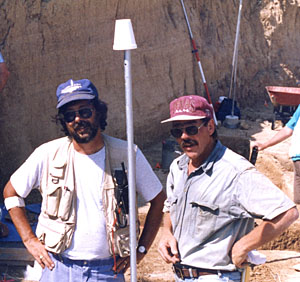Credits and Sources |
|
|
This exhibit was written in 2006 by Dr. Alston V. Thoms and TBH editorial assistant Jeff Taff. Portions were adapted from the final technical report on the Richard Beene investigations by Thoms and Rolfe Mandel. Heather Smith prepared the exhibit for the web. TBH editors Susan Dial and Carol Schlenk created the interactive learning module, "Dig through Layers of Time" with web develper Josh Leong. This exhibit was partially underwritten by grants from the National Endowment for the Humanities and the Texas Preservation Trust Fund (Texas Historical Commission). TBH partner organization the Southern Texas Archaeological Association (STAA) also helped sponsor the exhibit and deserves credit because many of its members participated in a STAA field school at the Beene site in 1994 and participated in other field work at Applewhite Reservoir. Thoms is professor of anthropology at Texas A&M University and directs the Archaeological-Ecological Laboratory. He directed over a decade of archeological research at the Beene site, most it of while serving as the director for the Center for Ecological Archaeology. His research interests center on the hunter-gatherers of North America and included land-use practices, tool-stone and cook-stone technology, heritage resources management, site-formation processes, archaeological ecology, and cooperative-research with American Indians and other archaeological stakeholders. He has carried out extensive archeological field research for over three decades in Texas, the Pacific Northwest, the Southwest, and the Southeast. Thoms' fieldwork in Texas spans more than 30 years, during which time he has worked closely with avocational archeologists, Native American groups, Civil War enthusiasts, and local historical organizations. Thoms is a sixth-generation Texan whose archeological interests date to his grade-school days in the Texas Panhandle when his father taught him how to find Indian campsites around playa lakes and along draws. To learn more about his research interests and accomplishments, see Thoms' TAMU faculty profile. All of the otherwise unattributed photographs were taken by TAMU archeologists, most of them by Thoms. Most of the graphics are taken from the forthcoming final report. TAMU Curator of Anthropology Patricia Clabaugh provided the images and graphics and has been involved with the Applewhite investigations since the early 1990s. She and her staff did all of the curation for the Richard Beene site collections and archives. Retired archeologist and active artist Dr. Frank A. Weir painted the "Life at Beene" scene. Print Sources:Mandel, Rolfe D., Alston V. Thoms, Lee C. Nordty, and John S. Jacobs Thoms, Alston V. and Rolfe D. Mandel, editors 1992 The Richard Beene Site: A Deeply Stratified Paleoindian to Late Prehistoric Occupation Site in South-Central Texas. Current Research in the Pleistocene 9:42-44. Thoms, Alston V., David D. Kuehn, Ben W. Olive, John E. Dockall, Patricia A. Clabaugh, and Rolfe D. Mandel Links:Richard Beene site Story Map Applewhite Bears More Fruit |
 Alston Thoms (on right) and Ben Olive at the Richard Beene site during the 1994 STAA field school. |